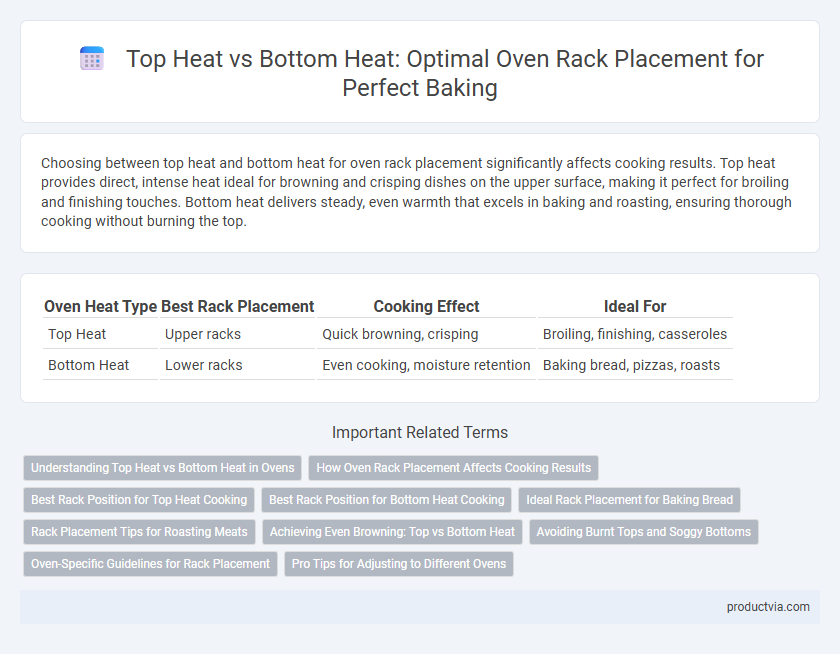Choosing between top heat and bottom heat for oven rack placement significantly affects cooking results. Top heat provides direct, intense heat ideal for browning and crisping dishes on the upper surface, making it perfect for broiling and finishing touches. Bottom heat delivers steady, even warmth that excels in baking and roasting, ensuring thorough cooking without burning the top.
Table of Comparison
| Oven Heat Type | Best Rack Placement | Cooking Effect | Ideal For |
|---|---|---|---|
| Top Heat | Upper racks | Quick browning, crisping | Broiling, finishing, casseroles |
| Bottom Heat | Lower racks | Even cooking, moisture retention | Baking bread, pizzas, roasts |
Understanding Top Heat vs Bottom Heat in Ovens
Top heat in ovens delivers direct heat from the upper heating element, ideal for broiling or browning the surface of dishes quickly, while bottom heat originates from the lower element, providing consistent warmth for baking or roasting. Choosing the correct oven rack placement depends on the heat source; placing dishes closer to the top element enhances crisping and caramelization, whereas positioning racks near the bottom element ensures even cooking and prevents burning. Understanding the distribution of top and bottom heat helps optimize cooking results by matching heat exposure with the recipe's requirements.
How Oven Rack Placement Affects Cooking Results
Oven rack placement significantly influences cooking results by controlling heat exposure to food through top Heat or bottom Heat distribution. Top heat provides direct radiant heat ideal for broiling and browning, while bottom heat delivers gentler warmth suitable for baking and slow cooking, ensuring even heat circulation. Selecting the correct rack position optimizes texture and doneness, preventing undercooking or burning by aligning food height with the primary heat source.
Best Rack Position for Top Heat Cooking
For top heat cooking, the best rack position is near the top third of the oven to ensure even browning and efficient heat exposure. Placing the rack too low can result in uneven cooking and reduced crispiness, while positioning it too close to the heating element risks burning food. Optimal rack placement maximizes direct radiant heat from the oven's upper heating element, ideal for broiling or finishing dishes with a golden crust.
Best Rack Position for Bottom Heat Cooking
Bottom heat in ovens is ideal for baking bread, pizzas, and casseroles as it ensures a crispy, well-cooked base by placing the rack in the lower third of the oven. Positioning the oven rack on the lowest or second-lowest level maximizes direct heat exposure from the bottom element, preventing soggy bottoms and promoting even cooking. Optimal rack placement for bottom heat enhances crust texture and guarantees thorough cooking of dense or dough-based dishes.
Ideal Rack Placement for Baking Bread
Baking bread benefits from placing the oven rack in the middle or slightly lower position to ensure even heat distribution. Top heat provides a strong crust formation, while bottom heat is crucial for thorough rising and preventing soggy bottoms. Balancing both heat sources by positioning the rack mid-oven achieves optimal crumb texture and crust development.
Rack Placement Tips for Roasting Meats
Positioning the oven rack in the middle or lower third is ideal for roasting meats, as bottom heat ensures even cooking and prevents burning the top surface. Using top heat can create a crisp, browned crust, so placing the rack higher helps achieve a desirable sear while maintaining juicy interiors. Combining both heat sources by adjusting rack placement allows optimal control over roasting results, balancing tenderness and browning.
Achieving Even Browning: Top vs Bottom Heat
Top heat in ovens promotes better browning on the upper surface of dishes, ideal for finishing touches like melting cheese or crisping crusts. Bottom heat excels at thoroughly cooking or baking items, ensuring even heat distribution for a firm base and preventing sogginess. Balancing top and bottom heat settings or adjusting oven rack placement optimizes even browning and consistent cooking results.
Avoiding Burnt Tops and Soggy Bottoms
Position the oven rack in the middle or lower third to prevent burnt tops caused by top heat concentration and avoid soggy bottoms from insufficient heat exposure. Use bottom heat for baking items like pizzas or casseroles where crisp bases are essential, while top heat suits browning or melting tasks such as gratins. Adjusting rack placement based on heat source optimizes baking results, ensuring even cooking and ideal texture without burning or sogginess.
Oven-Specific Guidelines for Rack Placement
Top heat in ovens provides intense, direct heat ideal for browning and crisping dishes placed on upper racks, while bottom heat is better for evenly cooking baked goods on lower racks without burning the surface. Oven-specific guidelines recommend positioning delicate items like cakes on middle or lower racks to avoid top heat overexposure, whereas roasting meats benefits from upper rack placement to utilize top heat for crust formation. Understanding these heat distribution patterns ensures precise oven rack placement for optimal cooking results and prevents uneven baking or burning.
Pro Tips for Adjusting to Different Ovens
Top heat in ovens provides intense browning, ideal for finishing dishes like gratins or broiling meats, while bottom heat excels at even baking and crisping crusts, crucial for items like pizza or bread. When adjusting to different ovens, rotate racks to manage heat exposure, placing delicate pastries on lower racks to avoid burning and positioning casseroles higher for thorough cooking. Monitor cooking times closely and use oven thermometers to account for temperature variations, ensuring optimal results regardless of the oven model.
Top Heat vs Bottom Heat for oven rack placement Infographic

 productvia.com
productvia.com